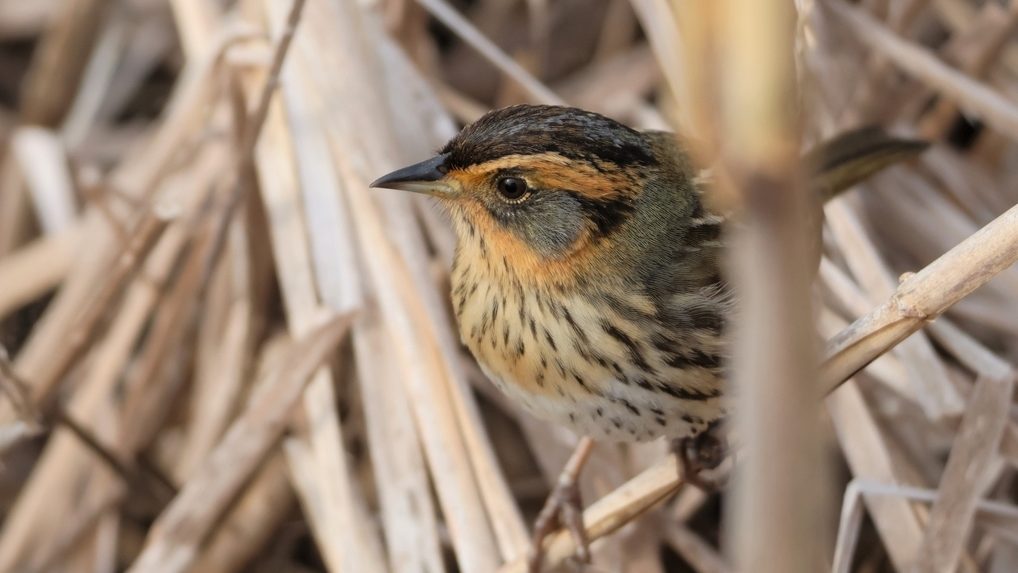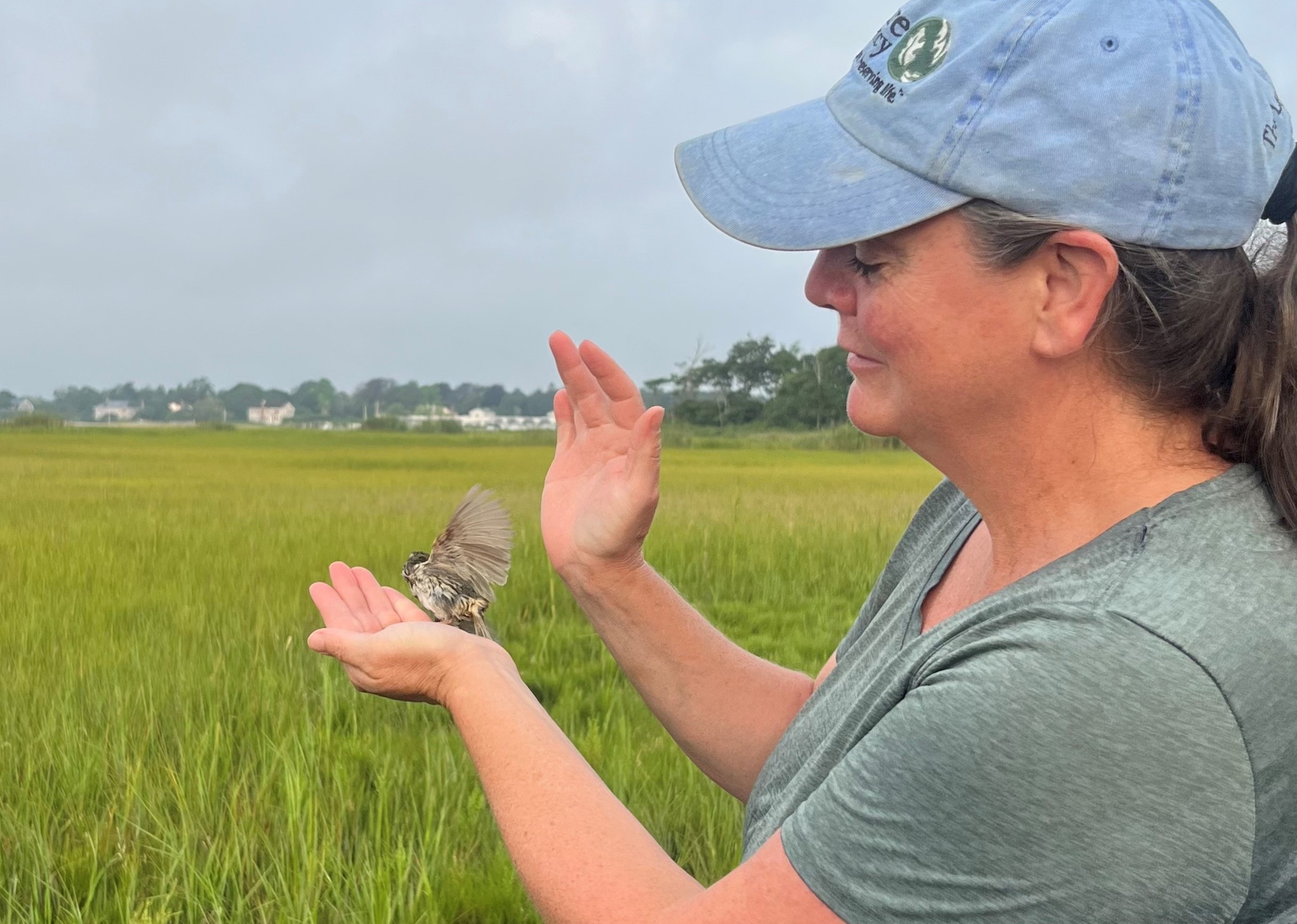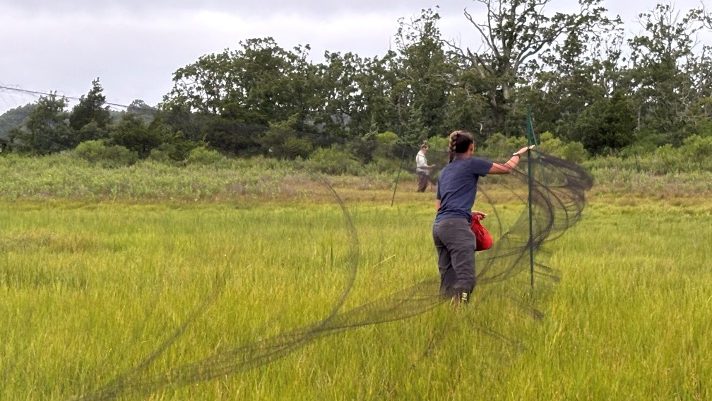The saltmarsh sparrow is a small puff of a bird that is uniquely adapted to living (and nesting) within a habitat that floods regularly. Endemic to the east coast of the United States, they are extreme salt marsh specialists and even build their nests in the intertidal zone.
It’s a life on the edge, and now dangerously so. Sea-level rise has made the sparrow’s existence unpredictable and precarious.
Researchers believe the sparrow could go extinct as early as 2035.
Let’s take a look at this fascinating little bird and why it faces such a troubling future.
The Mice of the Marsh
The saltmarsh sparrow is one of those species that can frustrate birders. They stick to coastal salt marsh habitats, nesting in cordgrass and salt hay along the Atlantic Coast from southern Maine to Virginia. (They winter in salt marshes a bit farther south).
They look like little fluffballs; birders warmly call them “mice of the marsh” for their habit of running along the marsh peat under the thick grass in order to keep their nesting locations secret.
“When they’re flying, they kind of look like oversized brown moths,” says Nicole Maher, senior coastal scientist for The Nature Conservancy in New York. “They’re just magical little birds.”

Maher is currently banding and tracking saltmarsh sparrows at conservation sites on Long Island. The reason it can be a challenge to find the bird is that they live in grasses within the intertidal zone.
It’s not an easy environment for a human to traverse. And, for that matter, it’s not easy for nesting birds, either, but they have managed to do so successfully for hundreds of thousands of years by evolving adaptations to help them survive in this tricky environment.
The saltmarsh sparrow’s nest hangs in vegetation just above the marsh surface and because marshes flood, nests are often inundated by high tides and storm events. How do they survive?
The sparrows, Maher says, have evolved to synchronize their nesting with the cyclical nature of the tides. Their nesting cycle has evolved to just fit within the 28-day lunar tidal cycle.

They have evolved to rapidly re-nest within a few days following a nest failure from flooding so that the next nest schedule will be synched with the lunar tides. According to Cornell’s All About Birds: “The most successful nests are those that are begun soon after the high tides of the new moon, because the eggs have a chance to hatch before the arrival of the high tides of the next full moon, two weeks later.”
“That first nest starts her cycle, sets her clock,” says Maher.
The eggs can also be immersed in saltwater for a couple of hours and still remain viable as long as the flooding is not so high as to float the eggs up and out of the nest cup. Chicks – at just 5 or 6 days old – can also climb higher up marsh grasses, literally keeping their head above water during high tides.
Newly hatched sparrows have a bright-yellow patch in their mouths so their mother can quickly feed them. “It looks like a big yellow target,” Maher says. “Just adorable.”
Male and female adults are indistinguishable from one another based on coloration. They are small brown birds with a light speckled chest and noticeable orange blazes on their face frequently described as an eyebrow and mustache pair.
The female birds are responsible for all of the nest building and parental care. The birds exhibit high site fidelity, frequently returning to the same marshes season after season.
The sparrow’s breeding and nesting behavior maximizes success when marsh elevations are able to keep up with sea level rise and tidal flooding is predictable. That is assuming normal lunar, tidal and flooding patterns. The problem is, things aren’t normal.

Of Sparrows and Sea-Level Rise
Saltmarsh sparrows have lost a lot of habitat to development and other pressures. But now they face their biggest threat, climate change.
While the sparrow is adapted to some flooding, their nests and chicks can’t withstand the increased unpredictable flooding events from coastal storms on top of regular lunar tidal flooding.
And as sea-level rise accelerates and weather patterns become more erratic with more frequent coastal flooding, dealing with nest flooding is getting harder for the birds. Loss of suitable habitat and flooding of low elevation nests are the primary causes of their population decline.

“If a saltmarsh sparrow is successful in nesting, it will return to the same site the next year. It will even nest within meters of the previous successful site,” says Maher. “But if it’s unsuccessful, it will hunt around to try different sites within the same marsh system.”
They generally only live 3 to 5 years, so even a few unsuccessful nesting years can cause them to disappear from marshes where they used to breed.
Populations of saltmarsh sparrows are declining across their entire range. Without intervention, climate and species population models predict that they will go extinct by the 2050s, perhaps as soon as 2035. They are currently under evaluation for listing under the Endangered Species Act; a determination is anticipated by September 2024.
“They’re the ‘canary’ of the salt marsh and of sea-level rise,” says Maher.
When a canary died in a coal mine, the miners knew of imminent danger. In a similar way, the saltmarsh sparrow’s fate carries with it a warning for the many other creatures that live in tidal marshes. And for humans.
“People rely on coastal habitats for protection from storms,” Maher says. “Sea-level rise poses a threat to all of us. The saltmarsh sparrow is an indicator of the changes happening.”
“The trouble for the sparrows is a problem in the marsh,” she continues. “In contrast, the success of saltmarsh sparrows in a marsh suggests levels of holistic coastal resilience with capacity to support a diversity of species and multiple marsh functions including risk reduction for people.”
Because of this, there is renewed immediacy to restore degraded marshes to address the marsh elevation growth that is needed to support their survival.

The Nature Conservancy and partners are researching saltmarsh sparrows as well as other obligate salt marsh birds like willets, seaside sparrows, and clapper and black rails.
“We want to see where these birds are successful, what the habitat is like and what makes it resilient,” says Maher. “We are prioritizing restoration of marshes that support sparrows where we can use light-touch restoration approaches to achieve resilience.”
This is especially important in designing and monitoring coastal restoration sites. Maher and other researchers have found that coastal marshes are not keeping up with sea-level rise. But she points out that vigorous growing conditions for plants and restored single-channel hydrology can make a difference in success.
“We want to determine what needs to be done to set marshes on a positive trajectory so that they can be self-sustaining in the face of climate change,” says Maher. “Doing so would benefit the saltmarsh sparrow, really a magical little creature that depends on this habitat for survival. And it would benefit people. Millions of people on Long Island and in other coastal communities depend on healthy coastal habitats in so many ways.”
